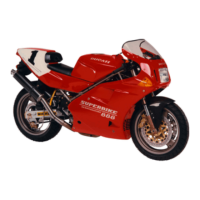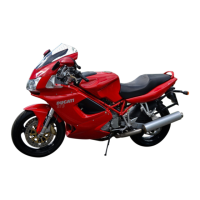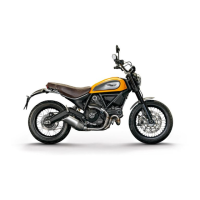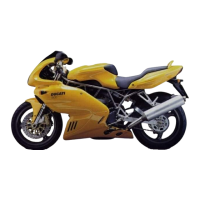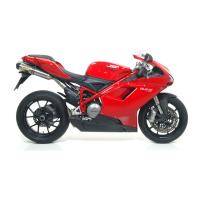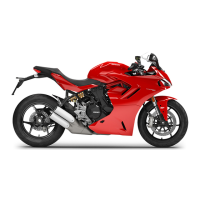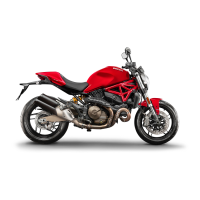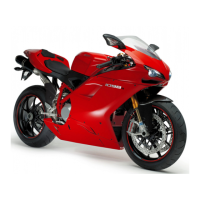Do you have a question about the Ducati SPORTCLASSIC PAUL SMART 1000 LIMITED EDITION 2006 and is the answer not in the manual?
| Displacement | 992 cc |
|---|---|
| Bore x Stroke | 94 x 71.5 mm |
| Transmission | 6-speed |
| Final Drive | Chain |
| Frame | Tubular steel trellis |
| Front Brakes | Dual 320 mm discs, 4-piston calipers |
| Front Tire | 120/70 ZR17 |
| Rear Tire | 180/55 ZR17 |
| Production Years | 2006 |
| Limited Edition | Yes |
| Engine Type | L-twin, 2 valves per cylinder |
| Power | 92 hp @ 8000 rpm |
| Torque | 91.2 Nm @ 6000 rpm |
| Fuel System | Electronic fuel injection |
| Exhaust | 2-into-1-into-2 |
| Front Suspension | 43 mm upside-down forks |
| Rear Suspension | Progressive linkage with adjustable preload |
| Rear Brakes | 2-piston caliper |
| Wheelbase | 1425 mm |
| Top Speed | 225 km/h (140 mph) |
| Fuel Capacity | 15 L / 3.9 US gal |
Details Ducati's warranty policy and conditions for motorcycle owners.
Explains the meaning of various symbols and warnings used in the manual.
Provides essential advice for safe operation, including protective gear and traffic rules.
Details the maximum load the motorcycle can carry and how to distribute it safely.
Locates and explains the importance of frame and engine identification numbers.
Illustrates and lists the location of all motorcycle controls on the handlebars and pedals.
Explains the purpose and behavior of various warning lights and indicators on the dashboard.
Details how to view and reset the trip meter and odometer on the LCD.
Guides on how to set and adjust the clock displayed on the instrument panel.
Explains the display for oil temperature and the fuel warning light.
Covers the maintenance indicator and how to adjust instrument panel backlighting.
Explains the function of the anti-theft immobilizer system and its electronic operation.
Details the types of keys provided and important warnings for their use and storage.
Explains the purpose and importance of the code card for the immobilizer system.
Provides step-by-step instructions to disable the engine block using the throttle twistgrip.
Describes how the system recognizes keys and what to do if the engine fails to start.
Explains the process and requirements for getting new keys made.
Details the four positions of the ignition switch and how to operate the steering lock.
Explains the function of the light dip switch and the turn signal controls.
Describes the horn button and the passing light function.
Details how to adjust the clutch lever and its importance for smooth riding.
Explains the operation of the engine stop switch and the starter button.
Describes the function of the throttle twistgrip for acceleration.
Explains how to operate and adjust the front brake lever.
Details how to operate the rear brake pedal.
Explains how to use the gear change pedal to select gears.
Provides instructions on how to adjust the gear change pedal for rider preference.
Details the procedure for adjusting the rear brake pedal for optimal reach and free play.
Identifies the location of major motorcycle components as shown in diagrams.
Explains how to open and close the fuel tank plug safely.
Guides on how to open the seat to access the compartment and helmet hook.
Details how to use the helmet hook to secure your helmet when parked.
Explains how to safely deploy, use, and retract the side stand.
Provides instructions on adjusting rear-view mirrors and important safety notes.
Describes the purpose of the steering damper and its location on the motorcycle.
Details how to adjust rebound and compression damping on the front forks.
Explains how to adjust the spring preload on the front forks.
Lists standard factory settings for front fork adjusters and important notes on adjustment.
Guides on adjusting rear shock absorber damping and spring preload.
Provides guidelines for operating the motorcycle during the first 1000 km for proper break-in.
Details recommended usage for the motorcycle between 1000 and 2500 km.
Lists critical checks to perform before riding for safety and vehicle condition.
Outlines steps for starting the engine, including ignition and indicator checks.
Explains the function of the starter button and assisted engine starting.
Guides on how to move off and shift gears smoothly and correctly.
Provides advice on using both brakes effectively and safely for stopping.
Details the correct steps to safely stop the motorcycle.
Explains how to park the motorcycle securely using the steering lock and side stand.
Provides instructions and warnings for safe and correct refuelling.
Describes the items included in the tool kit and where to find them.
Explains how to check and maintain brake and clutch fluid levels.
Details how to identify and address air in the clutch system.
Provides guidance on checking front and rear brake pads for wear.
Explains how to lubricate cables and joints for smooth operation.
Details the procedure for adjusting the throttle cable free play.
Provides instructions and safety precautions for charging the motorcycle battery.
Details safety measures for handling and charging the battery to prevent hazards.
Explains how to check and adjust the chain tension for optimal performance.
Guides on how to properly lubricate the motorcycle chain using specific products.
Details the procedure for replacing the headlight bulb.
Explains how to replace the parking light bulb.
Provides instructions for replacing the front turn indicator bulbs.
Details the procedure for changing the rear turn indicator bulbs.
Guides on how to access and replace the number plate light bulb.
Explains the process for replacing the stop and parking light bulbs.
Provides instructions on how to adjust the vertical beam of the headlight.
Details recommended tyre pressures and notes on adjusting them.
Provides guidance on tyre repair, replacement, and important safety warnings.
Explains how to measure tread depth and the minimum requirements.
Guides on how to check engine oil level and select the correct oil viscosity.
Details how to inspect, check gap, clean, and replace spark plugs.
Provides guidelines and warnings for safely cleaning the motorcycle.
Details the steps required to properly store the motorcycle for extended periods.
Covers important general notes and specific regulations for Australia.
Lists the overall dimensions and weight specifications of the motorcycle.
Details the types and capacities of fluids for top-ups and maintenance.
Provides specifications for the engine, including bore, stroke, and displacement.
Explains the Desmodromic timing system and its components.
Details the specifications for the front and rear brake systems.
Provides information on gear ratios, clutch type, and drive chain specifications.
Details specifications for the frame, wheels, and tyres.
Lists the make and type of spark plugs used in the motorcycle.
Provides specifications for the fuel system and front/rear suspensions.
Details the exhaust system compliance and available colours.
Lists the basic electric items and their bulb types.
Explains the location of the fuse box and the types of fuses used.
Instructs owners on how to report safety defects to NHTSA and Ducati.
Outlines the warranty for the exhaust system's noise emission compliance.
Explains the sources of emissions and Ducati's control systems.
Describes the California evaporation emission control system.
Outlines the terms and conditions of Ducati's limited warranty for emission control systems.
Details the scope of the warranty, including what is covered and where repairs can be done.
Lists exclusions and limitations of the emission control system warranty.
Explains Ducati's limited liability and the owner's legal rights under the warranty.
Provides additional details regarding the warranty period and maintenance responsibilities.

